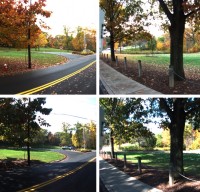
Most autonomous vehicles today are demonstrated and operate in relatively benign and unchanging environmental conditions. Certainly robots have been shown to be robust in off-road conditions and very rough terrain, but rarely can a single robot handle the wide variety of environmental conditions that people handle while driving on a daily basis. Such conditions include variations in lighting (e.g., daylight, sunset, dusk, or darkness) and variations in weather and aerial particulates (e.g., sunny, cloudy, raining, snowing, foggy, or dust clouds). In addition to short-term changes in the lighting and weather, the environment is constantly changing on a daily, weekly, and even yearly basis. Effects like seasonal change of the trees – from bare branches in winter to flowers in spring, green leaves in summer, and varying colors in the autumn – can significantly alter the appearance of the environment over the long term. Furthermore, man-made environmental changes can also alter the appearance of a scene dramatically on a short- or long-term basis. Movements of parked cars, construction or destruction of buildings, and replacement of billboard signs are just a few examples of such man-made changes. If an autonomous vehicle is expected to reliably operate in real environments for long time periods, it must be robust to variations in environmental conditions due to the natural effects of lighting, weather, and seasonal changes, as well as man-made changes.
While there has been work on characterizing sensors capabilities in different environmental conditions, and some work on making specific tasks, such as automatic cruise control, robust to some such conditions, the problem of making autonomous vehicles robust to environmental variations is still largely an open problem. The goal of this project is to investigate and develop methods for place recognition that are capable of handling long-term environmental variations.

